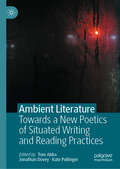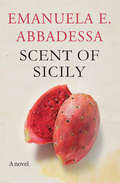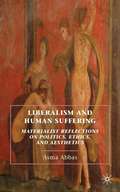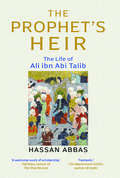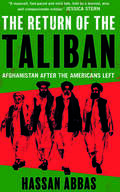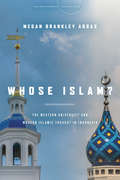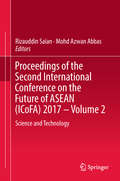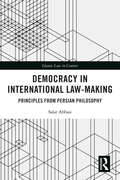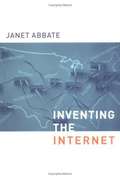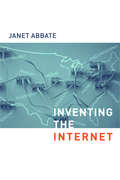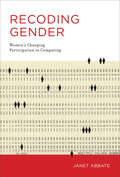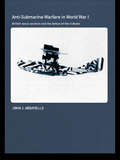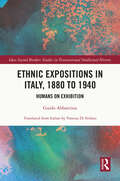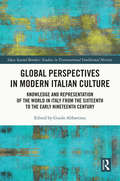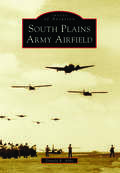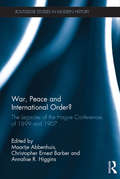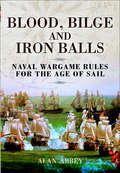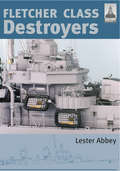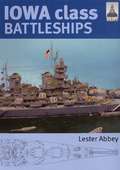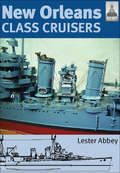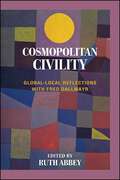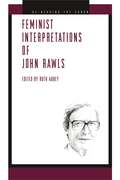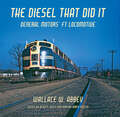- Table View
- List View
Ambient Literature: Towards a New Poetics of Situated Writing and Reading Practices
by Tom Abba Jonathan Dovey Kate PullingerThis book considers how a combination of place-based writing and location responsive technologies produce new kinds of literary experiences. Building on the work done in the Ambient Literature Project (2016–2018), this books argues that these encounters constitute new literary forms, in which the authored text lies at the heart of an embodied and mediated experience. The visual, sonic, social and historic resources of place become the elements of a live and emergent mise-en-scène. Specific techniques of narration, including hallucination, memory, history, place based writing, and drama, as well as reworking of traditional storytelling forms combine with the work of app and user experience design, interaction, software authoring, and GIS (geographical information systems) to produce ambient experiences where the user reads a textual and sonic literary space. These experiences are temporary, ambiguous, and unpredictable in their meaning but unlike the theatre, the gallery, or the cinema they take place in the everyday shared world. The book explores the potentiality of a new literary form produced by the exchange between location-aware cultural objects, writers and readers. This book, and the work it explores, lays the ground for a new poetics of situated writing and reading practices.
Scent of Sicily
by Emanuela E. AbbadessaAn impossible love, a noble, expansive Sicily, and a musical demon. A passionate novel with the power of a classic.Luigi has no worldly experience when, possessing only a few rags and the gift of an extraordinary tenor singing voice, he arrives in Sicily to seek his fortune. At the docks, as the crowd pushes him onto the gangway, he hears a sound emanating from a large black shape. It is a grand piano, and his instinct tells him to follow it.Hidden between the legs of the instrument, he arrives in a wagon at Capo Scirocco, with its elegant buildings and great baroque theatre. Having spent the night without shelter, he is famished and exhausted--but before long, he encounters the warm-hearted Rita Agnello, a rich widow and rare beauty who welcomes him into her home. Months go by and Luigi learns to live like a young nobleman at the side of Donna Rita. He feels at ease in the salons of Capo Scirocco, delighting in the warm wind for which the city was named--and which they say drives women wild. Even Rita seems different now--more lively and graceful.Then one day, Luigi discovers that the piano he caught sight of upon his arrival belongs to Anna, the daughter of a citrus-fruit merchant. Every evening, he listens to it from the street and dreams of singing. He is growing up, becoming a man . . . almost. When the scirocco blows, two women are too many to be on one young man's mind.
Liberalism and Human Suffering
by Asma AbbasThis book investigates the sources and implications of our encounters with suffering in contemporary politics and culture, exploring the forces that determine how suffering matters. It counters liberalism's distorting domestications of human suffering, which are most acute in its politics of redress through justice, the law, representation and inclusion. Radically rethinking the subjectivity of sufferers and arguing that our experience of the world is not prior to or outside of justice, but constitutive of it, the book recuperates a materialist politics that emphasizes sensuous activity, reclaims representation, and honors "the labor of suffering. ""
The Prophet's Heir: The Life of Ali ibn Abi Talib
by Hassan AbbasThe life and legacy of one of Mohammad&’s closest confidants and Islam&’s patron saint: Ali ibn Abi Talib Ali ibn Abi Talib is arguably the single most important spiritual and intellectual authority in Islam after prophet Mohammad. Through his teachings and leadership as fourth caliph, Ali nourished Islam. But Muslims are divided on whether he was supposed to be Mohammad&’s political successor—and he continues to be a polarizing figure in Islamic history. Hassan Abbas provides a nuanced, compelling portrait of this towering yet divisive figure and the origins of sectarian division within Islam. Abbas reveals how, after Mohammad, Ali assumed the spiritual mantle of Islam to spearhead the movement that the prophet had led. While Ali&’s teachings about wisdom, justice, and selflessness continue to be cherished by both Shia and Sunni Muslims, his pluralist ideas have been buried under sectarian agendas and power politics. Today, Abbas argues, Ali&’s legacy and message stands against that of ISIS, Al-Qaeda, and Taliban.
The Return of the Taliban: Afghanistan after the Americans Left
by Hassan AbbasThe first account of the new Taliban—showing who they are, what they want, and how they differ from their predecessors Since the fall of Kabul in 2021, the Taliban have effective control of Afghanistan—a scenario few Western commentators anticipated. But after a twenty-year-long bitter war against the Republic of Afghanistan, reestablishing control is a complex procedure. What is the Taliban&’s strategy now that they&’ve returned to power? In this groundbreaking new account, Hassan Abbas examines the resurgent Taliban as ruptures between moderates and the hardliners in power continue to widen. The group is now facing debilitating threats—from humanitarian crises to the Islamic State in Khorasan—but also engaging on the world stage, particularly with China and central Asian states. Making considered use of sources and contacts in the region, and offering profiles of major Taliban leaders, Return of the Taliban is the essential account of the movement as it develops and consolidates its grasp on Afghanistan.
Whose Islam?: The Western University and Modern Islamic Thought in Indonesia (Encountering Traditions)
by Megan Brankley AbbasIn this incisive new book, Megan Brankley Abbas argues that the Western university has emerged as a significant space for producing Islamic knowledge and Muslim religious authority. For generations, Indonesia's foremost Muslim leaders received their educations in Middle Eastern madrasas or the archipelago's own Islamic schools. Starting in the mid-twentieth century, however, growing numbers traveled to the West to study Islam before returning home to assume positions of political and religious influence. Whose Islam? examines the far-reaching repercussions of this change for major Muslim communities as well as for Islamic studies as an academic discipline. As Abbas details, this entanglement between Western academia and Indonesian Islam has not only forged powerful new transnational networks but also disrupted prevailing modes of authority in both spheres. For Muslim intellectuals, studying Islam in Western universities provides opportunities to experiment with academic disciplines and to reimagine the faith, but it also raises troubling questions about whether and how to protect the Islamic tradition from Western encroachment. For Western academics, these connections raise pressing ethical questions about their own roles in the global politics of development and Islamic religious reform. Drawing on extensive archival research from around the globe, Whose Islam? provides a unique perspective on the perennial tensions between insiders and outsiders in religious studies.
Proceedings of the Second International Conference on the Future of ASEAN (ICoFA) 2017 – Volume 2: Science And Technology
by Mohd Azwan Abbas Rizauddin SaianThis book examines how business, the social sciences, science and technology will impact the future of ASEAN. Following the ASEAN VISION 2020, it analyses the issues faced by ASEAN countries, which are diverse, while also positioning ASEAN as a competitive entity through partnerships. On the 30th anniversary of ASEAN, all ASEAN leaders agreed to the establishment of the ASEAN VISION 2020, which delineates the formation of a peaceful, stable and dynamically developed region while maintaining a community of caring societies in Malaysia, Indonesia, Singapore, Brunei, Vietnam, Thailand, the Philippines, Myanmar, Laos and Cambodia. In keeping with this aspiration, Universiti Teknologi MARA Perlis took the initial steps to organise conferences and activities that highlight the role of the ASEAN region. The Second International Conference on the Future of ASEAN (ICoFA) 2017 was organised by the Office of Academic Affairs, Universiti Teknologi MARA Perlis, to promote more comprehensive integration among ASEAN members. This book, divided into two volumes, offers a useful guide for all those engaged in research on business, the social sciences, science and technology. It will also benefit researchers worldwide who want to gain more knowledge about ASEAN countries
Democracy in International Law-Making: Principles from Persian Philosophy (Islamic Law in Context)
by Salar AbbasiThis book provides a critique of current international law-making and draws on a set of principles from Persian philosophers to present an alternative to influence the development of international law-making procedure. The work conceptualizes a substantive notion of democracy in order to regulate international law-making mechanisms under a set of principles developed between the twelfth and seventeenth centuries in Persia. What the author here names ‘democratic egalitarian multilateralism’ is founded on: the idea of ‘egalitarian law’ by Suhrawardi, the account of ‘substantial motion’ by Mulla Sadra, and the ideal of ‘intercultural dialectical democracy’ developed by Rūmī. Following a discussion of the conceptual flaws of the chartered and customary sources of international law, it is argued that ‘democratic egalitarian multilateralism’ could be a source for a set of principles to regulate the procedures through which international treaties are made as well as a criterion for customary international law-ascertainment. Presenting an alternative, drawn from a less dominant culture, to the established ideas of international law-making the book will be essential reading for researchers and academics working in public international law, history of law, legal theory, comparative legal theory, Islamic law, and history.
Inventing the Internet
by Janet AbbateSince the late 1960s the Internet has grown from a single experimental network serving a dozen sites in the United States to a network of networks linking millions of computers worldwide. In Inventing the Internet, Janet Abbate recounts the key players and technologies that allowed the Internet to develop; but her main focus is always on the social and cultural factors that influenced the Internets design and use. The story she unfolds is an often twisting tale of collaboration and conflict among a remarkable variety of players, including government and military agencies, computer scientists in academia and industry, graduate students, telecommunications companies, standards organizations, and network users. The story starts with the early networking breakthroughs formulated in Cold War think tanks and realized in the Defense Department's creation of the ARPANET. It ends with the emergence of the Internet and its rapid and seemingly chaotic growth. Abbate looks at how academic and military influences and attitudes shaped both networks; how the usual lines between producer and user of a technology were crossed with interesting and unique results; and how later users invented their own very successful applications, such as electronic mail and the World Wide Web. She concludes that such applications continue the trend of decentralized, user-driven development that has characterized the Internet's entire history and that the key to the Internet's success has been a commitment to flexibility and diversity, both in technical design and in organizational culture.
Inventing the Internet (Inside Technology)
by Janet AbbateJanet Abbate recounts the key players and technologies that allowed the Internet to develop; but her main focus is always on the social and cultural factors that influenced the Internet's design and use.Since the late 1960s the Internet has grown from a single experimental network serving a dozen sites in the United States to a network of networks linking millions of computers worldwide. In Inventing the Internet, Janet Abbate recounts the key players and technologies that allowed the Internet to develop; but her main focus is always on the social and cultural factors that influenced the Internets design and use. The story she unfolds is an often twisting tale of collaboration and conflict among a remarkable variety of players, including government and military agencies, computer scientists in academia and industry, graduate students, telecommunications companies, standards organizations, and network users.The story starts with the early networking breakthroughs formulated in Cold War think tanks and realized in the Defense Department's creation of the ARPANET. It ends with the emergence of the Internet and its rapid and seemingly chaotic growth. Abbate looks at how academic and military influences and attitudes shaped both networks; how the usual lines between producer and user of a technology were crossed with interesting and unique results; and how later users invented their own very successful applications, such as electronic mail and the World Wide Web. She concludes that such applications continue the trend of decentralized, user-driven development that has characterized the Internet's entire history and that the key to the Internet's success has been a commitment to flexibility and diversity, both in technical design and in organizational culture.
Recoding Gender: Women's Changing Participation in Computing (History of Computing)
by Janet AbbateThe untold history of women and computing: how pioneering women succeeded in a field shaped by gender biases.Today, women earn a relatively low percentage of computer science degrees and hold proportionately few technical computing jobs. Meanwhile, the stereotype of the male “computer geek” seems to be everywhere in popular culture. Few people know that women were a significant presence in the early decades of computing in both the United States and Britain. Indeed, programming in postwar years was considered woman's work (perhaps in contrast to the more manly task of building the computers themselves). In Recoding Gender, Janet Abbate explores the untold history of women in computer science and programming from the Second World War to the late twentieth century. Demonstrating how gender has shaped the culture of computing, she offers a valuable historical perspective on today's concerns over women's underrepresentation in the field.Abbate describes the experiences of women who worked with the earliest electronic digital computers: Colossus, the wartime codebreaking computer at Bletchley Park outside London, and the American ENIAC, developed to calculate ballistics. She examines postwar methods for recruiting programmers, and the 1960s redefinition of programming as the more masculine “software engineering.” She describes the social and business innovations of two early software entrepreneurs, Elsie Shutt and Stephanie Shirley; and she examines the career paths of women in academic computer science.Abbate's account of the bold and creative strategies of women who loved computing work, excelled at it, and forged successful careers will provide inspiration for those working to change gendered computing culture.
Anti-Submarine Warfare in World War I: British Naval Aviation and the Defeat of the U-Boats (Cass Series: Naval Policy and History)
by John AbbatielloInvestigating the employment of British aircraft against German submarines during the final years of the First World War, this new book places anti-submarine campaigns from the air in the wider history of the First World War. The Royal Naval Air Service invested heavily in aircraft of all types—aeroplanes, seaplanes, airships, and kite balloons—in order to counter the German U-boats. Under the Royal Air Force, the air campaign against U-boats continued uninterrupted. Aircraft bombed German U-boat bases in Flanders, conducted area and ‘hunting’ patrols around the coasts of Britain, and escorted merchant convoys to safety. Despite the fact that aircraft acting alone destroyed only one U-boat during the war, the overall contribution of naval aviation to foiling U-boat attacks was significant. Only five merchant vessels succumbed to submarine attack when convoyed by a combined air and surface escort during World War I. This book examines aircraft and weapons technology, aircrew training, and the aircraft production issues that shaped this campaign. Then, a close examination of anti-submarine operations—bombing, patrols, and escort—yields a significantly different judgment from existing interpretations of these operations. This study is the first to take an objective look at the writing and publication of the naval and air official histories as they told the story of naval aviation during the Great War. The author also examines the German view of aircraft effectiveness, through German actions, prisoner interrogations, official histories, and memoirs, to provide a comparative judgment. The conclusion closes with a brief narrative of post-war air anti-submarine developments and a summary of findings. Overall, the author concludes that despite the challenges of organization, training, and production the employment of aircraft against U-boats was largely successful during the Great War. This book will be of interest to historians of naval and air power history, as well as students of World War I and military history in general.
Ethnic Expositions in Italy, 1880 to 1940: Humans on Exhibition (Ideas beyond Borders)
by Guido AbbattistaComprehensively analyzing for the first time the phenomenon of ethnic living expositions in Italy between the 19th and 20th centuries, this book deals with the subject from a comparative European perspective and over the long term, studying analogies and differences in precedents as far back as the early modern age. The research, which seeks to go beyond the simplistic concept of "human zoos," intends to highlight the intentions, assumptions, and mechanisms of realization of the exhibitions of exotic living humans and the reactions from both the exhibited subjects and the public, exploiting a wide variety of heterogeneous sources capable of bringing out a kind of widespread popular ethno-anthropological ideas and the elements of racism contained in it. The book contributes to the understanding of Western mindsets and attitudes towards human diversity as they emerge from mass spectacular events that have over time become an international business. The present edition refers to the second Italian edition, containing an update discussing studies on the subject that have appeared between 2013 and 2021.Ethnic Expositions in Italy intends to fill a historiographical gap and to align Italian historiographies with European ones, which have long since come to terms with this legacy of the past and have explored its various historical manifestations in depth.This book is an excellent source for researchers and students alike, as well as those interested in the mechanisms that have helped shape European ideas and sensibilities on race and ethno-anthropological diversity.
Global Perspectives in Modern Italian Culture: Knowledge and Representation of the World in Italy from the Sixteenth to the Early Nineteenth Century (Ideas beyond Borders)
by Guido AbbattistaGlobal Perspectives in Modern Italian Culture presents a series of unexplored case studies from the sixteenth to the twentieth century, each demonstrating how travellers, scientists, Catholic missionaries, scholars and diplomats coming from the Italian peninsula contributed to understandings of various global issues during the age of early globalization. It also examines how these individuals represented different parts of the world to an Italian audience, and how deeply Italian culture drew inspiration from the increasing knowledge of world ‘Otherness’. The first part of the book focuses on the production of knowledge, drawing on texts written by philosophers, scientists, historians and numerous other first-hand eyewitnesses. The second part analyses the dissemination and popularization of knowledge by focussing on previously understudied published works and initiatives aimed at learned Italian readers and the general public. Written in a lively and engaging manner, this book will appeal to scholars and students of early modern and modern European history, as well as those interested in global history.
South Plains Army Airfield (Images of Aviation)
by Donald R. AbbeSouth Plains Army Airfield in Lubbock, Texas, was a major training base for US Army Air Force glider pilots during World War II. Approximately 80 percent of the roughly 6,000 pilots trained to fly the combat cargo glider received their advanced training and were awarded their "G" Wings at SPAAF, as it was known. The base was conceived, built, used, and then closed in a short five-year period during World War II. Today, little remains to remind one of the feverish and important military training program that once took place on the flat, featureless South Plains of Texas. During World War II, American military strategy and tactics included a significant airborne component. Major invasions, such as D-Day at Normandy, were preceded by huge aerial fleets carrying paratroopers and their equipment. These airborne invasion fleets sometimes exceeded well over 1,000 Allied gliders. The American airborne forces depended upon an ungainly looking aircraft, the CG-4A glider, to carry the vehicles, munitions, and reinforcements needed to survive. The pilots who flew them learned their trade at South Plains Army Airfield.
War, Peace and International Order?: The Legacies of the Hague Conferences of 1899 and 1907 (Routledge Studies in Modern History)
by Maartje Abbenhuis Christopher Ernest Barber Annalise R. HigginsThe exact legacies of the two Hague Peace Conferences remain unclear. On the one hand, diplomatic and military historians, who cast their gaze to 1914, traditionally dismiss the events of 1899 and 1907 as insignificant footnotes on the path to the First World War. On the other, experts in international law posit that The Hague’s foremost legacy lies in the manner in which the conferences progressed the law of war and the concept and application of international justice. This volume brings together some of the latest scholarship on the legacies of the Hague Peace Conferences in a comprehensive volume, drawing together an international team of contributors.
Blood, Bilge and Iron Balls: Naval Wargame Rules for the Age of Sail
by Alan AbbeyBlood, Bilge and Iron Balls is a set of wargame rules for naval battles in the age of sail. With them you can recreate the triumphs of Nelson or Hawke or tackle pirates on the Spanish Main. The rules themselves are very simple and easy to learn. Each player can easily command a single ship or several, the rules working equally well for a single frigate chasing down a privateer, or a large-scale fleet action with multiple players on each side. The basic rules have been written with the emphasis on providing a fast-playing and fun game, but optional rules are included which will add a greater level of historical realism and detail. A unique card-driven turn sequence prevents the game becoming too predictable. Also included are a selection of scenarios for re-fighting specific historical battles and simple campaign rules. Although intended for use with model ships, the rule book includes sheets of ship counters which can be used to get started. Just add dice, tape measure and pencil and you're ready to play.
Fletcher Class Destroyers (Shipcraft Ser.)
by Lester AbbeyThe 'ShipCraft' series provides in-depth information about building and modifying model kits of famous warship types. Lavishly illustrated, each book takes the modeller through a brief history of the subject class, using scale plans to highlight differences between sisterships and changes in their appearance over their careers, then moves to an extensive photographic survey of either a high-quality model or a surviving example of the ship. Hints on building the model, and on modifying and improving the basic kit, are followed by a section on paint schemes and camouflage, featuring numerous colour profiles and highly-detailed line drawings. The strengths and weaknesses of available kits of the ships are reviewed, and the book concludes with a section on research references—books, monographs, large-scale plans and relevant websites. The subject of this volume is the Fletcher class, often considered the most successful of all American destroyers. Built to the first design that was freed from treaty restrictions, they came into service near the beginning of the Pacific War and fought with distinction through all the most ferocious of the campaigns against Japan. They were constructed in large numbers, with a number of variations, and their popularity is reflected by the wide range of available kits.
Iowa Class Battleships
by Lester AbbeyThe 'ShipCraft' series provides in-depth information about building and modifying model kits of famous warship types. Lavishly illustrated, each book takes the modeller through a brief history of the subject class, highlighting differences between sister-ships and changes in their appearance over their careers. This includes paint schemes and camouflage, featuring colour profiles and highly-detailed line drawings and scale plans. The modelling section reviews the strengths and weaknesses of available kits, lists commercial accessory sets for super-detailing of the ships, and provides hints on modifying and improving the basic kit. This is followed by an extensive photographic gallery of selected high-quality models in a variety of scales, and the book concludes with a section on research references books, monographs, large-scale plans and relevant websites.The Iowa class were the largest, fastest and most modern US battleships of the war, and the formal surrender of Japan was signed on the deck of one of them, USS Missouri. Modernised post-war, they served in Korea, Vietnam and as late as the first Gulf War. They are among the most popular subjects of all for model kits.
New Orleans Class Cruisers (Shipcraft Ser. #No. 13)
by Lester AbbeyThe ShipCraft series provides in-depth information about building and modifying model kits of famous warship types. Lavishly illustrated, each book takes the modeller through a brief history of the subject class, highlighting differences between sister-ships and changes in their appearance over their careers. This includes paint schemes and camouflage, featuring colour profiles and highly detailed line drawings and scale plans. The modelling section reviews the strengths and weaknesses of available kits, lists commercial accessory sets for super-detailing of the ships, and provides hints on modifying and improving the basic kit. This is followed by an extensive photographic survey of selected high-quality models in a variety of scales, and the book concludes with a section on research references - books, monographs, large-scale plans and relevant websites.The subject of this volume is the seven-ship New Orleans class, probably the US Navys most hard-fought heavy cruisers of the War three were sunk in action but others survived massive damage, and by 1945 three out of four of the navys most decorated ships were of this class. Although designed within treaty limitations, they proved powerful and well-balanced ships, and their unparalleled fighting record makes them popular modelling subjects.
Cosmopolitan Civility: Global-Local Reflections with Fred Dallmayr
by Ruth AbbeyProlific and pioneering, Fred Dallmayr has been an active scholar for over fifty years. His research interests include modern and contemporary political theory, hermeneutics, phenomenology, the Frankfurt School, continental political thought, democratic theory, multiculturalism, environmentalism, and cosmopolitanism. Dallmayr is also one of the founders of comparative political thought and his interest in non-Western political theory spans Chinese, Islamic, Indian, Buddhist, and Latin American traditions. In emulation of the vast interdisciplinary and international character of Dallmayr's work, this book draws upon senior and emerging scholars from an array of disciplines and countries, with essays that are philosophical (in the Western and non-Western traditions), cultural and/or political, and international. Dallmayr himself responds to the essays in a concluding chapter.
Feminist Interpretations of John Rawls: Feminist Interpretations Of John Rawls (Re-Reading the Canon)
by Ruth AbbeyIn Feminist Interpretations of John Rawls, Ruth Abbey collects eight essays responding to the work of John Rawls from a feminist perspective. An impressive introduction by the editor provides a chronological overview of English-language feminist engagements with Rawls from his Theory of Justice onward. Abbey surveys the range of issues canvassed by feminist readers of Rawls, as well as critics’ wide disagreement about the value of Rawls’s corpus for feminist purposes. The eight essays that follow testify to the continuing ambivalence among feminist readers of Rawls. From the perspectives of political theory and moral, social, and political philosophy, the contributors address particular aspects of Rawls’s work and apply it to a variety of worldly practices relating to gender inequality and the family, to the construction of disability, to justice in everyday relationships, and to human rights on an international level. The overall effect is to give a sense of the broad spectrum of possible feminist critical responses to Rawls, ranging from rejection to adoption.Aside from the editor, the contributors are Amy R. Baehr, Eileen Hunt Botting, Elizabeth Brake, Clare Chambers, Nancy J. Hirschmann, Anthony Simon Laden, Janice Richardson, and Lisa H. Schwartzman.
Feminist Interpretations of John Rawls (Re-Reading the Canon)
by Ruth AbbeyIn Feminist Interpretations of John Rawls, Ruth Abbey collects eight essays responding to the work of John Rawls from a feminist perspective. An impressive introduction by the editor provides a chronological overview of English-language feminist engagements with Rawls from his Theory of Justice onward. Abbey surveys the range of issues canvassed by feminist readers of Rawls, as well as critics’ wide disagreement about the value of Rawls’s corpus for feminist purposes. The eight essays that follow testify to the continuing ambivalence among feminist readers of Rawls. From the perspectives of political theory and moral, social, and political philosophy, the contributors address particular aspects of Rawls’s work and apply it to a variety of worldly practices relating to gender inequality and the family, to the construction of disability, to justice in everyday relationships, and to human rights on an international level. The overall effect is to give a sense of the broad spectrum of possible feminist critical responses to Rawls, ranging from rejection to adoption.Aside from the editor, the contributors are Amy R. Baehr, Eileen Hunt Botting, Elizabeth Brake, Clare Chambers, Nancy J. Hirschmann, Anthony Simon Laden, Janice Richardson, and Lisa H. Schwartzman.
The Diesel That Did It: General Motors' FT Locomotive (Railroads Past and Present)
by Wallace W. AbbeyThe Diesel That Did It tells the story of the legendary diesel-electric locomotive, the FT.As war loomed in 1939, American railroads were on the precipice of railroad transformation. In an obscure factory in La Grange, Illinois, a group of gifted engineers and designers were planning a revolution that would shake railroading to its foundations and eventually put the steam locomotive out of business. Their creation, the FT, was a diesel-electric, semi-streamlined freight engine. The FT would establish a new standard for reliability, flexibility, and cost, but its arrival unsettled many railroad employees and gave fresh ammunition to their labor unions, who believed that it threatened a century-old culture.Wallace W. Abbey's The Diesel That Did It is the story of a revolution. He explores how EMC (and its successor Electro-Motive Division of General Motors) conceived the FT, and how it ultimately emerged as the dominant locomotive power plant for 20 years. However, for Abbey, the history of the Santa Fe Railway and the FT go hand in hand. The Diesel That Did It also offers a penetrating look at how the great American railroad, at the height of its Super Chief glamor, threw its conservative mechanical traditions aside to bet big on the diesel. Showcasing more than 140 exquisite photographs by Abbey and other noted photographers, The Diesel That Did It is a captivating story not to be missed by railroaders and railfans.
A Family Found
by Laura AbbotA Mother for His Sons Single father and rancher Tate Lockwood already has his hands full-and now he's been asked to escort a woman through the Western frontier! But beautiful Sophie Montgomery is as strong-willed as she is brave. And although she's not the conventional tutor he wants for his sons, she just might be the perfect fit. Sophie, still recovering from heartbreak, is ready to start life afresh. And that includes a startling new ambition-climbing Longs Peak in the Colorado Rockies-as well as teaching Tate's boys. When she starts to fall for this motherless family, Tate, who's suffered losses of his own, is reluctant to return her feelings. And yet, maybe they can help each other navigate the terrain of newfound love...
